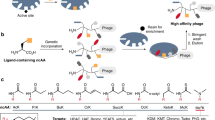Abstract
Monoclonal antibody PAb1620 recognizes a conformational epitope on the transcription factor p53 and, upon binding, allosterically inhibits p53 binding to DNA. A highly diverse (1.5×1010 members) phage-displayed library of peptides containing 40 random amino acids was used to identify the PAb1620 binding site on p53. Panning this library against PAb1620 resulted in three unique peptides which have statistically significant sequence identities with p53 sufficient to identify the binding site as being composed of amino acids 106–113 and 146–156. Based on these results, we propose a mechanism by which PAb1620 can allosterically inhibit p53 binding to DNA through an indirect interaction between the antibody binding site and the L1 loop (amino acids 112–124) of p53, which is a component of the DNA binding region.
This is a preview of subscription content, access via your institution
Access options
Subscribe to this journal
Receive 50 print issues and online access
$259.00 per year
only $5.18 per issue
Buy this article
- Purchase on Springer Link
- Instant access to full article PDF
Prices may be subject to local taxes which are calculated during checkout
Similar content being viewed by others
Author information
Authors and Affiliations
Rights and permissions
About this article
Cite this article
Ravera, M., Cárcamo, J., Brissette, R. et al. Identification of an allosteric binding site on the transcription factor p53 using a phage-displayed peptide library. Oncogene 16, 1993–1999 (1998). https://doi.org/10.1038/sj.onc.1201717
Received:
Accepted:
Published:
Issue Date:
DOI: https://doi.org/10.1038/sj.onc.1201717



